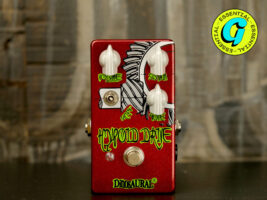
Coggins Audio Dinosaural Hypoid Drive review – a high-class overdrive with a difference
£218.99, cogginsaudio.co.uk
If you tend to judge guitar pedals by how they look, you might have a surprise coming here. The Dinosaural Hypoid Drive gives off a distinctly wild and scuzzy vibe – it actually reminds me of the cover of the first Pavement album – but this thing is about as lo-fi as the London Symphony Orchestra.
READ MORE: EarthQuaker Devices Easy Listening review – can an amp simulator this simple actually sound good?
Could this be a deliberate attempt by Dinosaural supremo Dan Coggins, one of the most exalted figures in stompbox history, to broaden the brand’s appeal beyond the somewhat saturated market of high-class overdrives? Or to look at it another way, is he trying to throw a few blues dentists off the scent?
Image: Richard Purvis
Dinosaural Hypoid Drive – what is it?
Coggins was the circuit designer behind the near-mythical Lovetone pedals of the 90s, but the direct origins of the Hypoid Drive don’t go back quite that far: this is the latest evolution of his first offering under the Dinosaural name, the Tube Bender of 2003. That later turned into the OPA-101, and more recently found itself repurposed as the central section of the Cogmeister boost/drive/boost leviathan. And now it’s gone solo again.
So, we’re looking at a transparent-ish overdrive pedal with a much wider gain range than most, from light crunch to something like full-on fuzz. It has controls for volume, sustain (drive) and tone, plus a three-way toggle switch for reshaping the mids. That’s one up on the two-way switch of the old Tube Bender – which is great news, because it means now I don’t have to cry every time I think of the one I used to own and idiotically sold. That is, as long as the Hypoid Drive sounds as good…
Image: Richard Purvis
Dinosaural Hypoid Drive – what does it sound like?
It sounds as good! Not that I have the old pedal to compare it with (see above), but through a clean amp the Hypoid Drive is so instantly magical that my ears refuse to believe it could possibly be better. Tonally it’s not completely uncoloured – there’s a distinct softening of the midrange – but, combined with rounded bass and clear treble, that just serves to make everything that little bit sweeter.
The gain range is just as wide as advertised: as you crank the sustain knob you feel it morph from low-gain fluffy drive into something close to a Fuzz Face or Big Muff – and that word ‘feel’ is key here, because what this pedal does best of all is disappear under your fingers. That is, it doesn’t sound like a pedal and it doesn’t respond like one either: the dynamics are so pure, you’d swear your amp had just grown an extra gain stage (or two).
The toggle switch also exceeds expectations: the middle position is fully open, and what the left and right settings offer is effectively a choice of two kinds of dip to the lower mids. They sound very different and the thinning effect can be quite extreme, but as long as you’re judicious with the tone control it never gets trashy. I could certainly find uses for all three positions without upsetting those blues dentists.
Image: Richard Purvis
Dinosaural Hypoid Drive – should I buy it?
You shouldn’t buy it if you don’t like overdrive pedals that sound and feel like the gods of Mount Olympus pouring nectar directly into your brain. You shouldn’t buy it if it’s out of your budget. And you probably shouldn’t buy it if you already have a Tube Bender, an OPA-101 or a Cogmeister. Beyond that, sorry – I’m all out of excuses.
Dinosaural Hypoid Drive alternatives
To be fair, there are plenty of other pedals that take transparent overdrive in a smooth and silky direction. You might also look at the Great Eastern FX Co Design-A-Drive (£229), the Silktone Overdrive+ ($269/£279) or the J.Rockett HRM V2 ($229/£239)… and let’s not forget Dan Coggins’ current day job at ThorpyFX, whose Peacekeeper (£224.99) specialises in sweet low-gain crunch.
The post Coggins Audio Dinosaural Hypoid Drive review – a high-class overdrive with a difference appeared first on Guitar.com | All Things Guitar.
Source: www.guitar-bass.net











